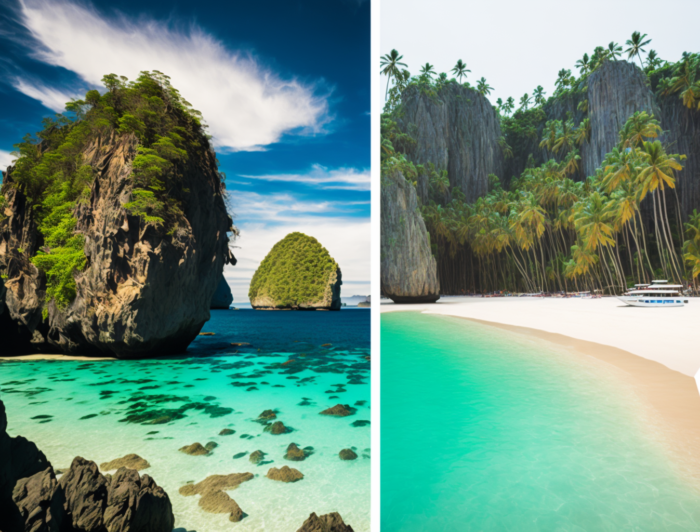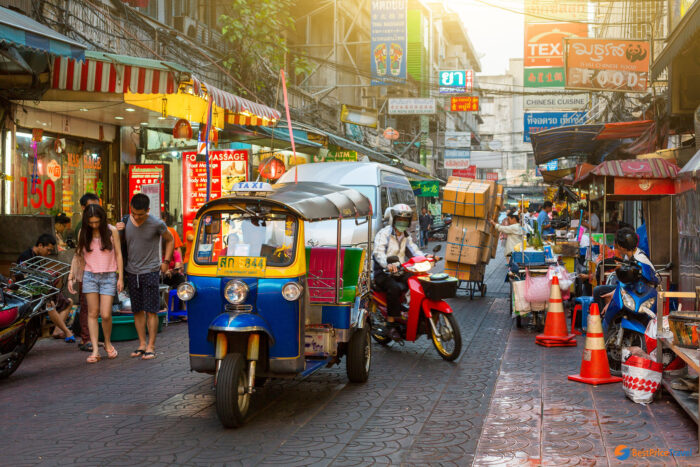Retiring in a new country can be an exciting and rewarding experience, but it’s important to do your research and consider all the factors that will impact your decision. In this blog post, we’ll be comparing the experience of retiring in the Philippines versus Thailand. Both countries have a lot to offer, with their own unique cultures, climates, and cost of living. We’ll explore all these factors and more to help you make an informed decision about where to retire. Whether you’re looking for a tropical paradise with affordable living costs or a more developed country with top-notch healthcare, this article will provide you with the information you need to decide which of these two countries is the right fit for you. So, let’s get started!

Cost of living
When it comes to cost of living, both the Philippines and Thailand have their own unique advantages and disadvantages.
In the Philippines, the cost of living is generally lower compared to many Western countries. Housing costs can be quite affordable, with the average monthly rent for a one-bedroom apartment in a city center ranging from around $300 to $500. Outside of the city center, rent can be even lower. The cost of groceries and other daily expenses is also relatively low, with a meal at a local restaurant averaging around $3-$5. Healthcare costs are also generally lower in the Philippines compared to many Western countries, with a visit to a doctor averaging around $20-$30.
However, it’s worth noting that the cost of living can vary significantly depending on which city or region you live in. For example, living costs in the capital city of Manila are generally higher compared to other parts of the country. Additionally, the cost of living in tourist areas such as Boracay and Palawan can be significantly higher due to the higher demand for goods and services.
Thailand also has a relatively low cost of living compared to many Western countries. Housing costs can be quite affordable, with the average monthly rent for a one-bedroom apartment in a city center ranging from around $300 to $600. The cost of groceries and other daily expenses is also relatively low, with a meal at a local restaurant averaging around $3-$5. Healthcare costs are also generally lower in Thailand compared to many Western countries, with a visit to a doctor averaging around $20-$30.
However, it’s worth noting that the cost of living in Thailand has been steadily increasing in recent years due to rising inflation. Additionally, the cost of living can vary significantly depending on which city or region you live in. For example, living costs in the capital city of Bangkok are generally higher compared to other parts of the country.
Overall, the cost of living in both the Philippines and Thailand is generally lower compared to many Western countries. However, it’s important to keep in mind that the cost of living can vary significantly depending on which city or region you live in and the specific expenses you have. It’s always a good idea to do your own research and budgeting to determine which country is more affordable for you based on your specific needs and lifestyle.

Climate & Geography
The climate and geography of both the Philippines and Thailand can have a significant impact on the decision to retire in either of these countries.
The Philippines is a country made up of over 7,000 islands located in Southeast Asia. It has a tropical climate with high humidity and temperatures ranging from around 75-90 degrees Fahrenheit. The country experiences a wet and dry season, with the wet season typically lasting from June to November and the dry season lasting from December to May. The Philippines is also prone to typhoons and other natural disasters, which can be a consideration when deciding where to retire.
In terms of geography, the Philippines is home to a variety of landscapes including beaches, mountains, and rice terraces. The country is known for its beautiful beaches, with popular destinations including Boracay, Palawan, and Siargao. The country is also home to the highest mountain in Southeast Asia, Mount Apo, as well as the Banaue Rice Terraces, which are listed as a UNESCO World Heritage Site.
Thailand is a country located in Southeast Asia, bordered by Cambodia, Laos, and Malaysia. It has a tropical climate with high humidity and temperatures ranging from around 75-95 degrees Fahrenheit. The country experiences a wet and dry season, with the wet season typically lasting from May to October and the dry season lasting from November to April. Thailand is not prone to typhoons, but it can experience other natural disasters such as floods and earthquakes.
In terms of geography, Thailand is home to a variety of landscapes including mountains, forests, and beaches. The country is known for its beautiful beaches, with popular destinations including Phuket, Koh Samui, and Krabi. The country is also home to the highest mountain in Thailand, Doi Inthanon, as well as several national parks and forests.
Overall, both the Philippines and Thailand have tropical climates with high humidity and temperatures. The Philippines is prone to typhoons and other natural disasters, while Thailand is not. Both countries have a variety of landscapes, including beaches, mountains, and forests. When deciding where to retire, it’s important to consider the climate and geography of the area you’re considering and how it will impact your lifestyle and comfort.

Healthcare
When it comes to healthcare, both the Philippines and Thailand have their own unique advantages and disadvantages.
The healthcare system in the Philippines is generally lower in cost compared to many Western countries. The country has a mix of public and private hospitals, with both offering relatively affordable healthcare. The quality of healthcare can vary, with some hospitals offering high-quality care while others may be less well-equipped. There are also a number of international hospitals in the Philippines that offer high-quality care at a higher cost.
One significant difference in healthcare between the Philippines and many Western countries is the availability of certain medical procedures and treatments. Some medical procedures and treatments may not be available in the Philippines, or may only be available at a higher cost. It’s important to keep this in mind when considering healthcare in the Philippines and to do your own research to determine whether the medical care you need is available in the country.
The healthcare system in Thailand is generally lower in cost compared to many Western countries. The country has a mix of public and private hospitals, with both offering relatively affordable healthcare. The quality of healthcare in Thailand is generally high, with many international hospitals located in the country that offers top-notch care.
One advantage of healthcare in Thailand is the availability of medical tourism, with many people traveling to the country specifically for medical treatment. Thailand is known for its affordable and high-quality medical tourism, with a wide range of procedures available at a lower cost compared to many Western countries.
Overall, both the Philippines and Thailand have relatively affordable healthcare systems compared to many Western countries. The quality of healthcare can vary in the Philippines, while Thailand is known for its high-quality healthcare. It’s important to keep in mind that the availability of certain medical procedures and treatments may be different in each country and to do your own research to determine whether the medical care you need is available in the country you’re considering.

Cultural and societal factors
Cultural and societal factors can play a significant role in the decision to retire in a new country. Both the Philippines and Thailand have their own unique cultures and societies, with their own traditions, values, and ways of life.
The Philippines is a country with a diverse culture influenced by a mix of indigenous, Spanish, and American influences. The country is predominantly Catholic, with a strong emphasis on family and community. The culture is generally warm and welcoming, with a strong emphasis on hospitality and respect for elders. English is widely spoken in the Philippines, making it easier for English speakers to communicate and integrate into the community.
Thailand is a country with a diverse culture influenced by a mix of indigenous, Chinese, and Indian influences. The country is predominantly Buddhist, with a strong emphasis on spirituality and respect for elders. The culture is generally warm and welcoming, with a strong emphasis on hospitality and maintaining a sense of calm and balance. English is widely spoken in Thailand, making it easier for English speakers to communicate and integrate into the community.
Both the Philippines and Thailand have strong family and community ties, with a strong emphasis on respect for elders. However, there are some notable differences in the cultures of these two countries. For example, the Philippines has a stronger Spanish influence, which is reflected in the country’s language, architecture, and cuisine. Thailand has a stronger Chinese and Indian influence, which is reflected in the country’s language, architecture, and cuisine.
When deciding where to retire, it’s important to consider the cultural and societal factors of the country you’re considering and how they will impact your lifestyle and comfort. It’s also a good idea to do your own research and talk to people who have retired in the country you’re considering to get a sense of what it’s like to live there.

Pros & Cons: Philippines vs Thailand
When it comes to retiring in the Philippines versus Thailand, there are both pros and cons to consider. Here is a list of some of the main pros and cons of retiring in each of these countries:
Pros of retiring in the Philippines:
Lower cost of living compared to many Western countries.
Beautiful beaches and other natural attractions.
Warm and welcoming culture.
Strong family and community ties.
English is widely spoken.
Cons of retiring in the Philippines:
Some medical procedures and treatments may not be available.
Quality of healthcare can vary.
Prone to natural disasters such as typhoons.
Infrastructure may not be as developed as in some Western countries.
Pros of retiring in Thailand:
Lower cost of living compared to many Western countries.
Beautiful beaches and other natural attractions.
Warm and welcoming culture.
Strong family and community ties.
English is widely spoken.
High-quality healthcare and medical tourism.
Cons of retiring in Thailand:
Some medical procedures and treatments may be more expensive compared to other countries in Southeast Asia.
Infrastructure may not be as developed as in some Western countries.
Culture and societal norms may be different from those in Western countries.
Overall, both the Philippines and Thailand have their own unique pros and cons when it comes to retiring. It’s important to consider all the factors that are important to you, such as cost of living, healthcare, climate and geography, culture and societal factors, and any other specific needs or preferences you may have. It’s also a good idea to do your own research and talk to people who have retired in either of these countries to get a sense of what it’s like to live there.
Summary:
In conclusion, retiring in the Philippines or Thailand can be a rewarding and exciting experience, with each country offering its own unique advantages and disadvantages.
When considering retiring in the Philippines, it’s important to keep in mind that the cost of living is generally lower compared to many Western countries, with affordable housing, groceries, and healthcare. The country has beautiful beaches and other natural attractions, and a warm and welcoming culture with strong family and community ties. However, it’s worth noting that the quality of healthcare can vary in the Philippines and some medical procedures and treatments may not be available. The country is also prone to natural disasters such as typhoons.
When considering retiring in Thailand, similar to the Philippines… the cost of living is generally lower compared to many Western countries, with affordable housing, groceries, and healthcare. Likewise it too has beautiful beaches and other natural attractions. Thailand is known for its high-quality healthcare and medical tourism, making it a good option for those in need of medical treatment. However, it’s worth noting that some medical procedures and treatments may be more expensive in Thailand compared to other countries in Southeast Asia, and the cultural and societal norms may be different from those in Western countries. There is also a language barrier in Thailand as English is not spoken as predominantly as it is in the Philippines.
Overall, both the Philippines and Thailand have a lot to offer for those considering retiring to a new country. It’s important to do your own research and consider all the factors that are important to you when deciding which country is the right fit for you. This may include factors such as cost of living, healthcare, climate and geography, culture and societal factors, and any other specific needs or preferences you may have. It’s also a good idea to talk to people who have retired in either of these countries to get a sense of what it’s like to live there. There are many expat groups on Facebook where you can inquire from those living there for ‘boots on the ground’ feedback.
Get more information on the Philippines, over 1,000 videos at LifeBeyondTheSea Youtube

